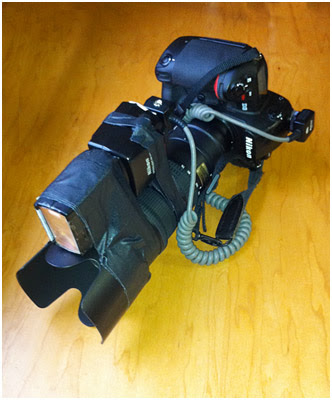On Assignment: On Camera, On Axis, On Budget
Ever notice that the on-camera flash shots from your point-and-shoot camera can actually look … kinda good?
That's because those cameras are so small that an onboard flash acts more like a ring light than a DSLR-style on-camera flash. Here is how to get that look with your DSLR, some gaff and an OCF cord.
__________
On-camera direct flash for DSLR is located just about the worst position possible. Move it a little further away (with a bracket) and it looks better. Move it a little closer and it looks better.
The on-camera flash totin', celebrity-shootin' paparazzi know this. That's why you'll usually see them with either vertical flash brackets or the side brackets made popular by Terry Richardson. The side brackets get the flash very close to the lens for a look that is a little more brash (and, oddly, glamorous) than your normal, on-camera flash.
I like to do that one better and put the flash adjacent to the lens. The light looks decent by itself (better if you warm the flash) but I prefer it as fill as it was used above. Plus, it is more powerful than a speedlight-based, passive ring flash adapter. So it can work for you in full sun. (It won't replace a ring, as that has a different look.)
Here is the fill setup as used on pianist Daria Scarano, above. I photographed her for the cover of her new CD of selections from Franz Liszt. (Photographing a Liszt album cover is especially cool to me, as long-time readers will know.)
Here, the speedlight is being used as fill. It's pretty cheap as mounting systems go. I used gaffer's tape and an old TTL cord. The SC-17 TTL cord, used, is about $20 on eBay. Although, probably not this week.
Lighting ratio for using an on-axis bare flash as fill is pretty much add-salt-to-taste. I establish the fill exposure first, crank the aperture down to where I like the legibility, then add in the key with the power adjusted to get a full exposure form that. In this case, the key was a dish at upper camera left.
On last tip: even though the flash is right next to the lens, location matters. Ideally, you'll be on the opposite (or near opposite) side as your key light. In this case I shot with the camera rotated to place the flash on the bottom. That allowed the full-exposure key light from above to eliminate the tiny little hairline shadow this setup can give as fill.
Next: Antonio Beverly
__________
New to Strobist? Start here | Or jump right to Lighting 101
My new book: The Traveling Photograher's Manifesto
Permalink


<< Home